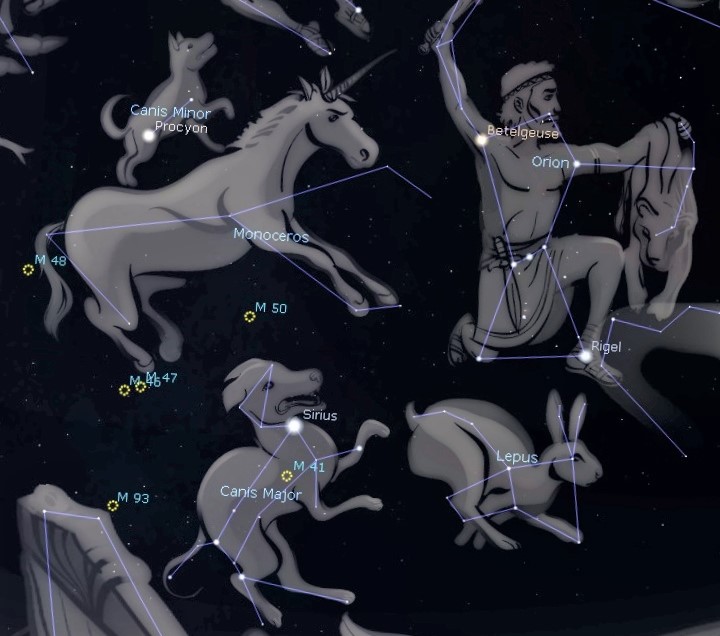
2025 December 27 – 2026 January 3
Around midnight in the first week of January the brightest star in the night sky is due south, at its highest above the horizon. Astronomers would say it is transiting the meridian when it crosses the north-south line. Many 19th century observatories, including the one now called the William Brydone Jack Observatory at UNB Fredericton, would collaborate in timing the transits of stars to determine the longitudes of their observatories.
Sirius is called the Dog Star because it is part of the constellation Canis Major the Great Dog, one of Orion’s hunting companions. If you are unsure which star is Sirius, follow Orion’s Belt down to the left. The star is about twice the size of the Sun and 25 times more luminous, but that is not why it is the brightest. It is only 8.6 light years away, 82 trillion kilometres, and the nearest naked eye star for us in New Brunswick. The name means “scorcher” or “scintillating one” and it often twinkles wildly and colourfully, especially when it is lower in the sky. I like to observe it with binoculars or a telescope just to enjoy the light show. Look for the star cluster M41 about a binocular field below Sirius. With the Sun passing above Orion in summer, people once believed the hot days were due to extra heat from Sirius, hence the term “dog days of summer.”
This Week in the Solar System
Saturday’s sunrise in Moncton is at 8:00 and sunset will occur at 4:40, giving 8 hours, 40 minutes of daylight (8:02 and 4:48 in Saint John). Next Saturday the Sun will rise at 8:01 and set at 4:46, giving 8 hours, 45 minutes of daylight (8:03 and 4:54 in Saint John). Earth is at perihelion early afternoon on January 3, a mere 147.1 million kilometres from the Sun.
The Moon is at first quarter this Saturday and full early next Saturday morning. On Tuesday we can watch it creeping up on the Pleiades star cluster. Mercury will be a difficult binocular object, rising about 50 to 30 minutes before sunrise over the week. Saturn sets around 11 pm this week, and Jupiter rises in evening twilight as it nears opposition on January 10. On Tuesday telescope users might see the shadow of Jupiter’s moon Ganymede crossing the planet from 6:04 to 9:20, with the moon itself trailing by about an hour. After opposition the moons will precede their shadow. The Quadrantid meteor shower peaks on January 3.
The Saint John Astronomy Club meets in the Rockwood Park Interpretation Centre on January 3 at 7 pm. The Sunday Night Astronomy Show resumes on January 4.Questions? Contact Curt Nason at [email protected].
December 20 – December 27
As we approach the end of the year, step outside some clear evening and take a look around the sky. This time of year many of the brightest stars are at their best when you face south. Halfway up the sky around 11 pm is the slanted line of three stars that forms Orion’s Belt. Above it are the shoulders of the giant hunter, marked by reddish-orange Betelgeuse and Bellatrix to its right. Below, blue-white Rigel and Saiph are parts of Orion’s legs. The Belt points to the right at the V-shaped Hyades star cluster, anchored by orange Aldebaran, and to the compact, eye-catching Pleiades cluster; which together form the face and shoulder of Taurus the Bull.
To the lower left of the Belt is the night sky’s brightest star, Sirius, in Canis Major, the larger of Orion’s two canine companions. Bellatrix and dim Meissa, marking Orion’s head, form an arrowhead with Betelgeuse at the tip, which points toward Procyon in two-star Canis Minor. Auriga and Gemini ride above Orion. Among these winter constellations are five of the ten brightest stars, with 12 more in the top fifty.
Rather than make a New Year’s resolution that involves great sacrifice and likely won’t see February, why not start an astronomy project to learn the sky over the year. I recommend the RASC Explore the Universe program, which involves observing and describing or sketching objects using your unaided eyes, binoculars or a small telescope. The objects include constellations and bright stars, lunar features, the solar system, double stars, and deep sky objects like the hazy binocular nebula M42 below Orion’s Belt. By observing 55 of the 110 objects you could earn a certificate and a pin. For details, see https://www.rasc.ca/explore-universe or contact me.
This Week in the Solar System
Saturday’s sunrise in Moncton is at 7:58 and sunset will occur at 4:35, giving 8 hours, 37 minutes of daylight (8:00 and 4:43 in Saint John). Next Saturday the Sun will rise at 8:00 and set at 4:40, giving 8 hours, 40 minutes of daylight (8:02 and 4:48 in Saint John). The Sun reaches its winter solstice point at 11:03 on Sunday morning to kick off a new season.
The Moon is new on December 19 and waxes to first quarter on December 27. It will be near Saturn on Boxing Day, and that evening the Lunar X might be fully formed for telescope users around 10 pm. Mercury rises after most kids do on Christmas, just before 7 am. Jupiter rises at 6 that evening and Saturn sets after 11:30, so try your new telescope out on both. On Sunday telescope users might see Jupiter’s moon Io fade into the planet’s shadow at 8:54 and reappear on the other side at 11:39, with Jupiter’s Red Spot visible during most of that stretch. The Ursid meteor shower peaks on Sunday with some shooting stars sloshing from the Little Dipper in the north.
Tune in to the Sunday Night Astronomy Show at 8 pm on the YouTube channel and Facebook page of Astronomy by the Bay. And have a stellar Christmas. Questions? Contact Curt Nason at [email protected].